|

Agricultural Consulting
Service
Geography of our projects
Publisert:
12.11.2020 | Oppdatert:
23.05.2025
Secrets of sunflower
growing. Modern sunflower vsrieties from Strube
This
article created for
Strube,
a leading breeder in the World
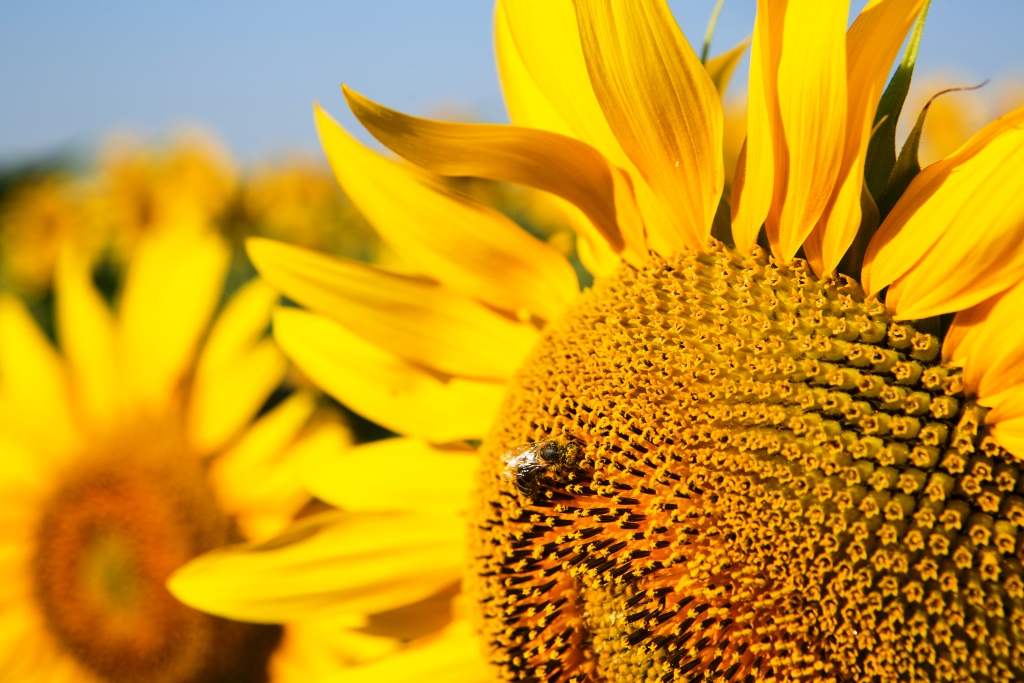
Photo source:
Strube
Strube Company not
only offers the best and most high yielding wheat and sugar beet
varieties, but also launches new sunflower varieties on the market
Modern sunflower
varieties from Strube.
The right choice of
sunflower varieties for different agro-climatic zones
Strube company offers for different climatic conditions, modern
sunflower varieties which show higher yields and profitability than
varieties of well-known competitors.
Strube Company offers a new system of geographic regionalization of
sunflower hybrids. As not only sunflower variety's yield, but also the
profit from variety that growing depends from the proper choosing of the
variety for local conditions!
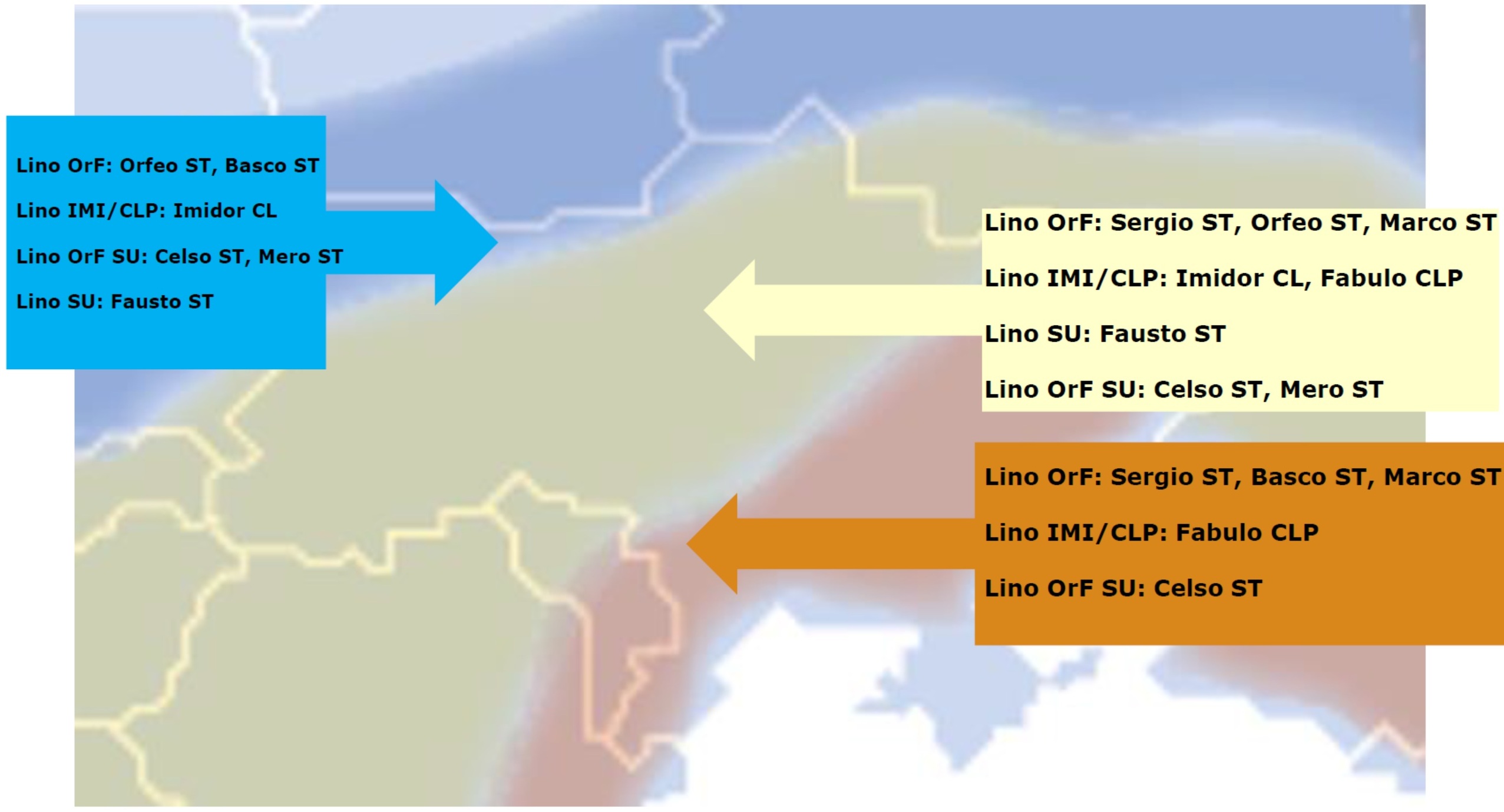
Figure
source:
Strube
Zoning map of Strube sunflower varieties, 2019. This figure shows which
varieties are best for growing in a particular agro-climatic zone of
Ukraine. Abbreviations: Lino - linoleic, OrF - resistant to broomrape of
race F (Orobanche cumana), SU - sulfonyl-resistant (herbicide Express resistant), IMI -
herbicide-resistant Clearfield® technology (Euro Lightning herbicide)
Best
agroclimatic zones of Ukraine for growing of Strube sunflower varieties
|
|
|
Type of variety |
Name of variety |
Agroclimatic
zone |
Description |
|
Zone
1 |
Zone
2 |
Zone
3 |
Tolerance to herbicides |
Oil type |
Or
(tolerance
to Orobanche cumana) |
DM
(tolerance to
Plasmopara halstedii) |
Maturity group |
|
Classical |
Basco |
|
|
|
|
Lino |
F/Or6 |
P2 |
2 |
|
Orfeo |
|
|
|
|
Lino |
F/Or6 |
P1 |
4 |
|
Sergio |
|
|
|
|
Lino |
F/Or6 |
P2 |
5 |
|
Sulfo - sulfonyl-herbicide
resistant (herbicide Express resistant) |
Celso |
|
|
SU |
Lino |
F/Or6 |
P1 |
3 |
|
Fausto |
|
|
SU |
Lino |
E/Or5 |
P1 |
4 |
|
EXS 5407 |
|
|
|
SU |
Lino |
E/Or5 |
|
6 |
|
Tango |
|
|
|
SU |
Lino |
E/Or5 |
P2 |
7 |
|
Mero |
|
|
SU |
Lino |
F/Or6 |
P2 |
7 |
|
IMI - herbicide-resistant Clearfield® technology (Euro
Lightning herbicide resistant) |
Fabulo |
|
|
|
IMI + |
Lino |
E/Or5 |
P5 |
4 |
|
Imidor |
|
|
|
IMI |
Lino |
E/Or5 |
P4 |
5 |
|
HО+IMI -
high oleic
+
IMI - herbicide-resistant Clearfield® technology (Euro
Lightning herbicide resistant) |
EXS 3526 |
|
|
IMI + |
HO |
E/Or5 |
P2 |
6 |
|
|
|
|
|
|
|
|
|
|
|
|
|
|
best results of growing
in agroclimatic zone |
|
|
average
results of growing in agroclimatic zone |
|
|
Growing is possible but only
in case of careful care and agronomy cosulting service |
Source:
Strube,
2019
IMI
(sunflower variety that
herbicide-resistant Clearfield® technology (Euro
Lightning herbicide resistant)
IMI+
(sunflower variety that
herbicide-resistant Clearfield®
Plus
technology)
SU (sunflower
variety that sulfonyl-herbicide resistant (herbicide Express resistant)
HO
(high
oleic)
Lino
(lino)
Or
(tolerance
to Orobanche cumana Wallr.)
F,
E
(Orobanche
cumana Wallr.
race name)
DM
(tolerance
to Plasmopara halstedii (Farl.)
Berl. et de Toni.)
P1, P2 ...
(Plasmopara halstedii (Farl.) Berl.
et de Toni.
race name)
Features of choosing of sunflower varieties. Sowing several varieties of
Strube!
When choosing varieties
of sunflower, the following important factors should be considered:
-
geographical location and local
climatic conditions, agroclimatic zoning of sunflower varieties
-
high oil content for linoleic
varieties and oleic acid content for high oleic
-
ype of resistance of the variety to
herbicides (sulfo, IMI or IMI +, classic)
-
the best sunflower yields for your
region from market leaders, Strube data, and own test results
-
resistance to broomrape and those
diseases that are common at your fields
-
it should be used in production not
one, but 3-5 different varieties from Strube, in which case stable
results will be provided, since depending on a particular year, one
or another sunflower varieties will be have higher yields
-
you should regularly test new
sunflower varieties , because the breeding does not stand still, and
Strube breeders are constantly creating new, more productive and
profitable varieties - and maybe they will suit your conditions!
High-quality pollination is an important factor in high productivity for
modern sunflower varieties
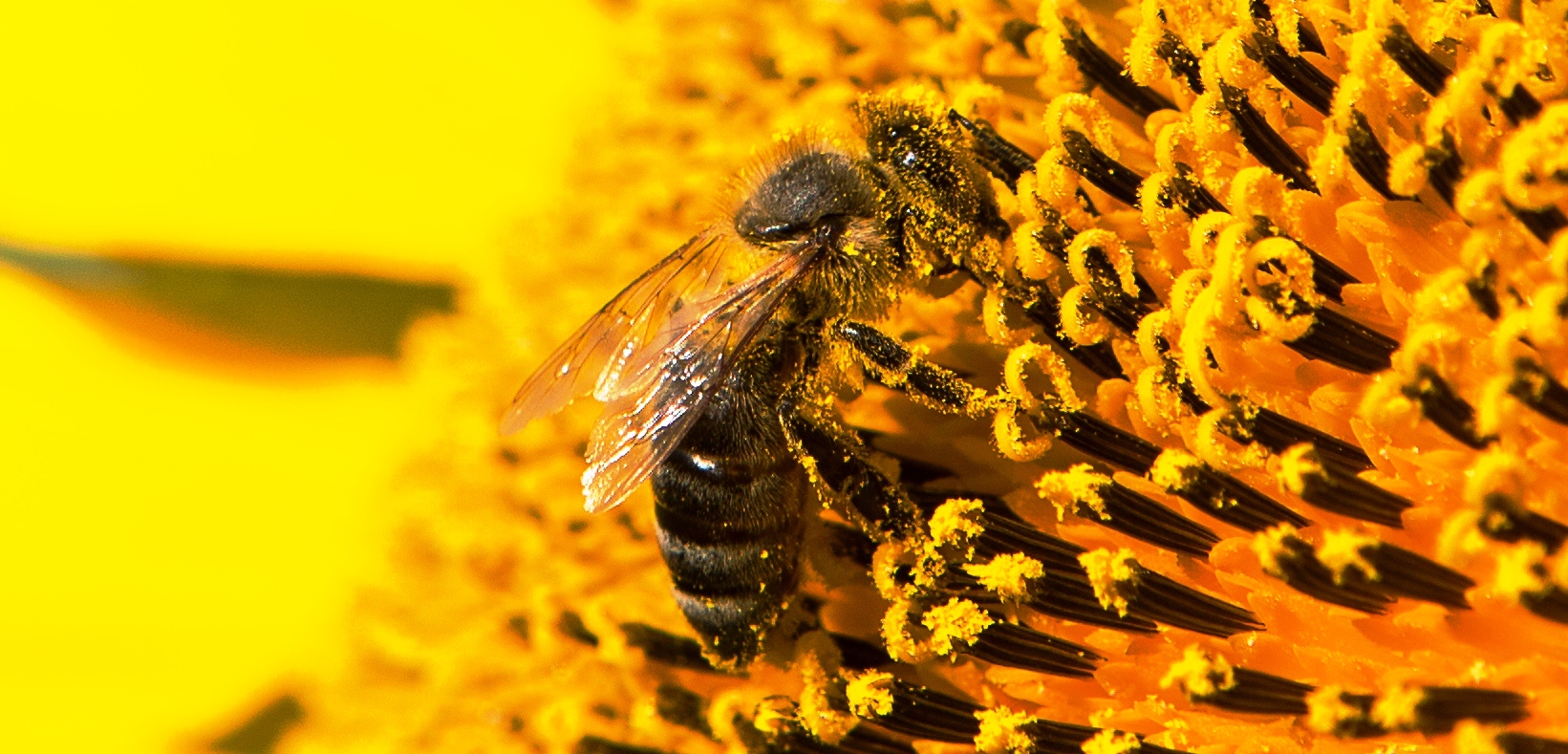
Photo
source:
Strube
Sunflower it ia a
plant that polinated by bees. If bees are absent that good yield will
absent too. And high-quality pollination is very important for for high
yield of modern sunflower varieties. But in case of good polination will
be absence of empty seeds. In addition, bees are not only a high
increase in the yield of sunflower, but also given an additional profit
from the sale of honey
One of the factors that causes sunflower
seeds emptiness is poor pollination by bees. Often, highly productive
varieties form empty seeds and give a low yield due to the absence of
bees at the time of flowering of the sunflower heads.
Sunflower is a plant that is pollinated by
insects, including bees. Sunflower is an important honey plant.
For obtain high sunflower yields,
pollination by bees is recommended (at least 2 bee colonies per
hectare).
Bees significantly increasing the
sunflower yield.
It is also unacceptable to use
insecticides (various insecticides) on blooming sunflower, which leads
to the death of bees and / or their larvae. Of the available
insecticides, Biscaya (Bayer) and Mospilan (Nippon Soda) do the least
harm, which should be used only at night, and bees need to be closed (isolated)
for prevention for 2 days.
For
obtaining of high yield of oil per hectare, sunflower plants must remain
green and healthy for as long as possible!
If
the sunflower plants remain green and healthy until fully ripe, the
greater will be the yield and oil content in the seeds.
Thus,
for obtain a high yield of oil per hectare, sunflower plants must be
healthy and have good resistance to a complex of diseases and pests.
Not
only good monitoring of the state of crop is necessary, but also need
timely and correctly planned treatments with fungicides and
micronutrient fertilizers, which contribute to the healthy development
of plants without stress.
Sowing disease-resistant varieties, contributes to a significant
reduction in investment in the purchase of fungicides, as can be seen in
the following photo.
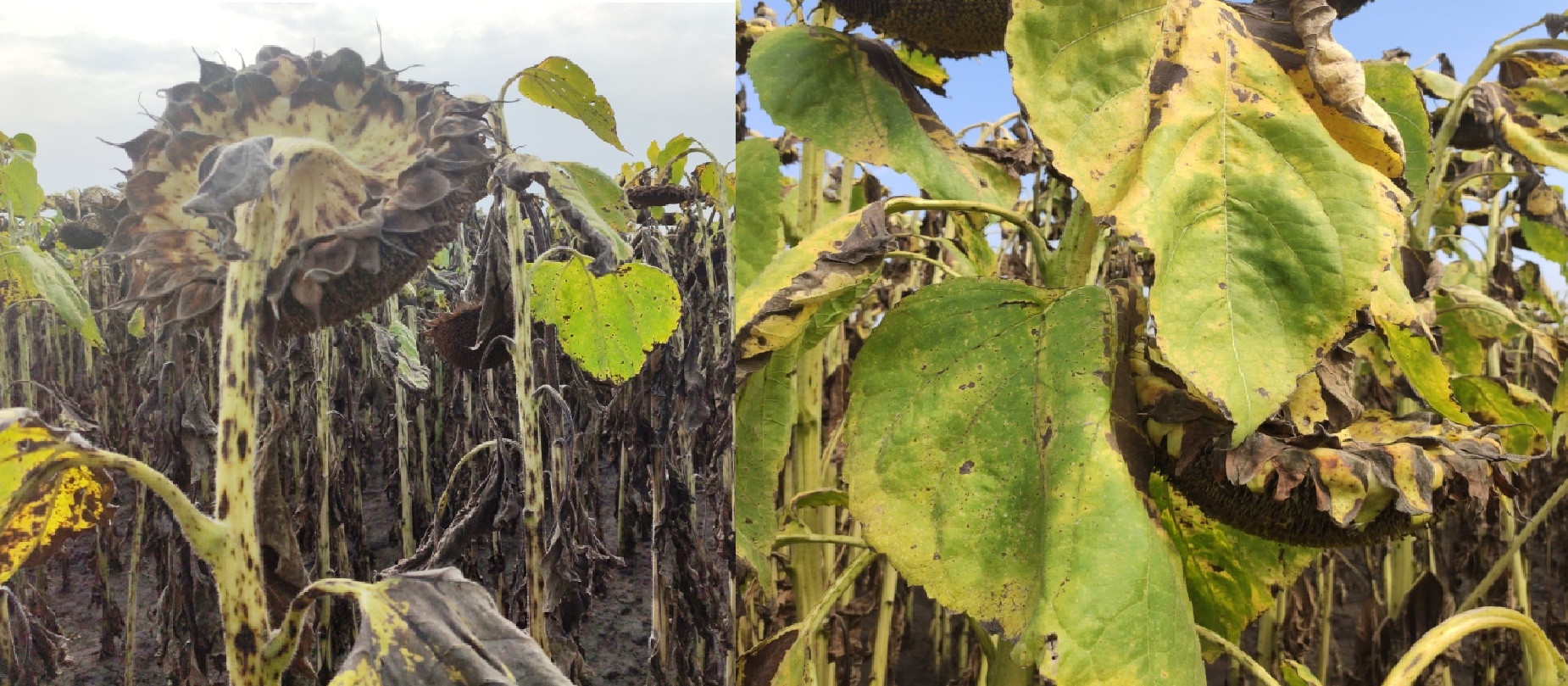
Resistance to diseases is an
important factor in reducing costs and making extra profit when growing
sunflower. At the photo: on the right - a sunflower variety from Strube
that resistant to Alternaria; on the left is an unstable variety (control).
The photo took place on the same field, 28 of August 2019, the
scientific field Strube, Hungary. Alternaria is a very harmful and
recently very widespread disease, not only in Europe, but also in
Ukraine (in Poltava, Khmelnitsky, Chernihiv and Kiev, and other regions).
Photo ©
Dr. Oleksii Orlov
High-quality sowing and even
placement of
seeds in a row
Usually,
sunflower sowing is carried out in a point manner with 70 cm
destination between rows with precision
seeders. With the point method of sowing seeds in a row are placed
evenly, at regular intervals according to a given sowing rate. Uniform
placement of seeds across the field is a very important condition for
obtaining high yields of sunflower. If plants are placed unevenly, then
sunflower plants begin to compete with each other for nutrients and
light, which leads to significant lower yields.
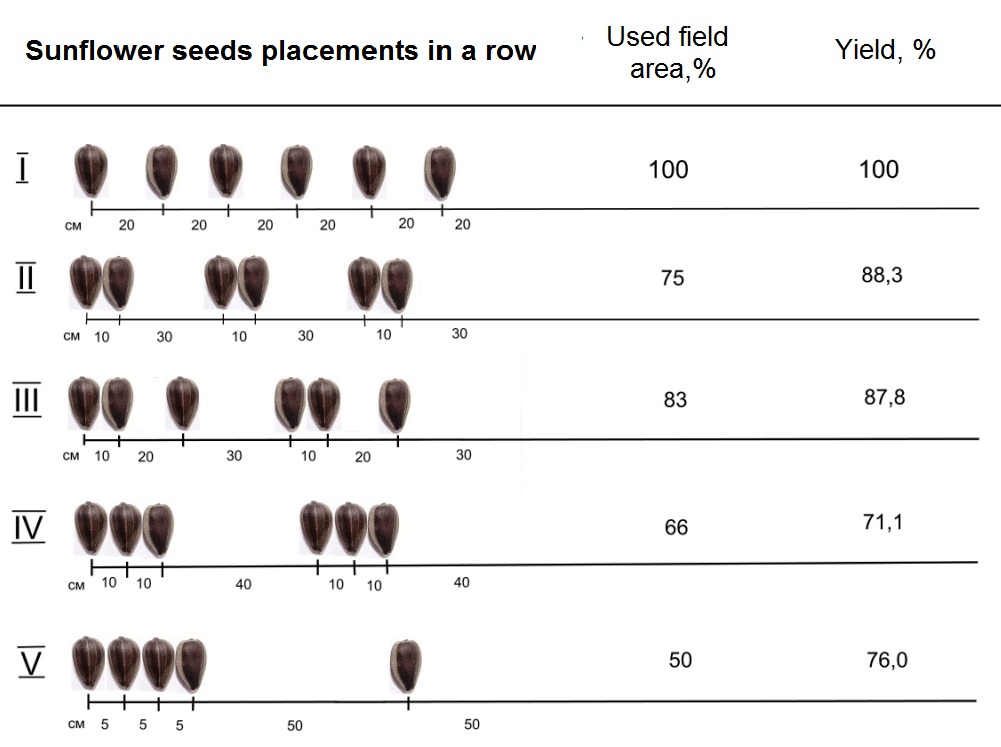
The effect of uniform seeds placement in a row to the sunflower yield.
If the seeds in the row are placed unevenly, a significant decrease in
yield is observed (Fig. ©
Dr. Oleksii Orlov)
The distance between plants in the row should be 28-52 cm (with a sowing
rate of 35-45 thousand seeds/ha), 19-36 cm (with a sowing rate of 50-65
thousand seeds/ha), 11-26 cm (with a seeding norm of 70-110 thousand
seeds/ha). When sowing sunflower seeds by the point method, it is easy
to achieve the optimal area of plant nutrition. With an optimal
feeding area, standing density is obtained at which the maximum yield is
formed.
When calculating the density of plant standing, it is necessary to
proceed, first of all, from the level of moisture supply in local
conditions. With a lack of moisture in the soil, the standing density is
reduced, and with a sufficient level of moisture, seed treatment with
micronutrient fertilizers and growth stimulants, as well as with high
doses of fertilizers, are increased.
Sunflower is the most sensitive
crop for not right rates of sowing and for density of plants in field.
With dense sowing of sunflover, losses can be 70-80%!

It is important to
carry out the sowing of sunflower with precision seeders, since the
uniform placement of seeds in the row depends on this. If the seeds are
place unevenly, a 10-50% decrease in sunflower yield can be observed due
to the fact that plants compete with each other for light, water and
nutrients, and weeds occupy the empty spaces between them. At the photo
- sowing is done correctly, the distance between plants is optimal, the
yield will be high (photo ©
Dr. Oleksii Orlov)
Some people sow sunflower with the help of
pneumatic sowing planters designed for sowing grain crops without any
conversion (to achieve the desired row spacing, they simply turn off or
remove the coulters). In this case, the placement of seeds in the row is
not controlled, and yield reduction can be up to 10-50%, although this
method provides a higher sowing speed and a shorter time for sowing. But
it is not a way that it is possible sowing more and in time but not
obtain a good yield and not obtain a profit. The following photo shows
the incorrect placement of plants in a row when sowing seeds with a big
pneumatic planter, leading to a decrease in yield.
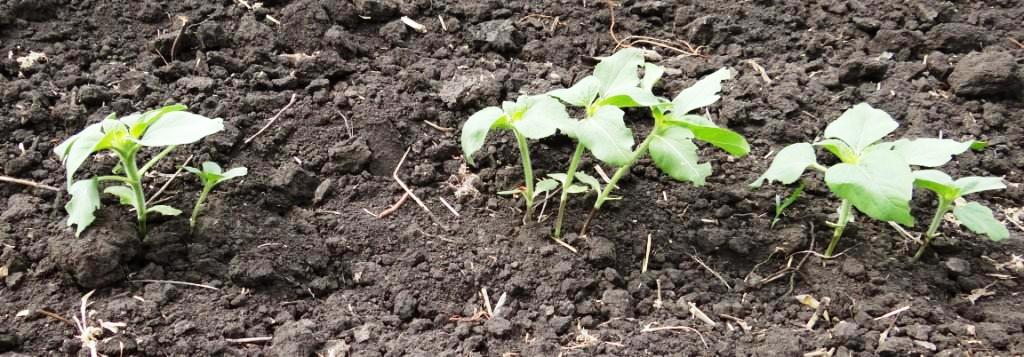
At the photo - sunflower sowing is performed
incorrectly, the yield will be significantly reduced (photo ©
Dr. Oleksii Orlov)
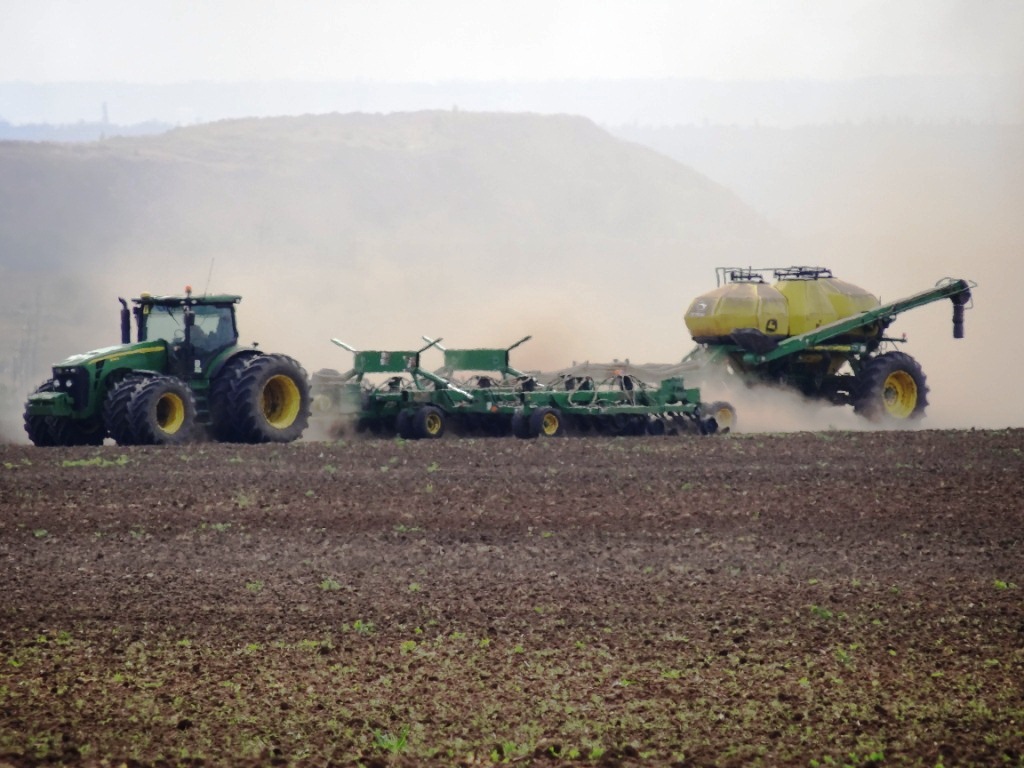
Although
big planter for grain crops can be used for
sowing of sunflower seeds, this is not
recommended, since with an uneven placement of
seeds in a row, yield losses can reach 10-50%. The advantage of this
sowing method is a higher sowing rate. But with this method of sowing
sunflower, you can sow a lot and quickly, but you can’t get profit
(photo ©
Dr. Oleksii Orlov)
Focus on high oleic sunflower from
Strube
Growing high oleic sunflower is a more profitable
business than growing ordinary sunflower. The purchase price for high
oleic sunflower is much higher. Therefore, to grow high oleic sunflower
is more profitable than ordinary. In the global market, the demand for
high oleic oil is higher. This is due to the fact that high oleic
sunflower oil is more stable when heated, and is much healthier. The
excellent prospects of high oleic sunflower are evidenced by the fact
that most sunflower fields in Europe (particularly in France) are high
oleic sunflower.
Strube is introduces modern competitive high oleic
varieties of sunflower to the market.
Features of growing Strube sunflower in
the Forest zone (Polesie)
If you grow sunflower in the Forest zone or Western
Ukraine or in Transcarpathia, then in most cases this is sowing in
fields with acidic soils.
It is necessary to plan correctly the use of fertilizers
for sunflower on acidic soils!
On acidic soils, with decreasing pH values (less than
5.7), the availability of key nutrients either decreases very much or
increases to such a level that mineral nutrients become toxic to
sunflower plants.
Most often present the toxicity is aluminum contained in
soils. On neutral soils, a high concentration of aluminum or manganese
will not be toxic to plants. But a high concentration of aluminum (AlKCl)
or manganese will be toxic and will lead to a sharp decrease in the
yield of sunflower on acidic soils.
A low pH can also lead to the fact that not only aluminum
and manganese, but also copper, zinc and boron can become toxic to
plants. A high level of concentration of these ions in soils may cause
the appearance of symptoms of deficiency of various nutrients in
sunflower plants. A high concentration of soluble aluminum and / or
manganese in soils can be an obstacle to the absorption, transport and
use of certain nutrients by the plant (phosphorus, calcium, magnesium,
molybdenum and potassium).
This leads to the fact that plants cannot absorb these
substances and their deficiency arises, although under different
conditions, this amount of nutrients would be quite enough for the
normal development of sunflower plants.
One of the significant factors that limiting sunflower
yield may also be phosphorus deficiency in acidic soils, since
phosphorus under such conditions can bind to aluminium and iron in
chemical compounds insoluble and inaccessible to sunflower plants.
Thus, on acidic soils, a whole complex of factors acts,
the balance of nutrients and their availability is disrupted, which
leads to disruption of the basic physiological processes in sunflower
plants, and this, in turn, causes a decrease in yield or death of crop.
Visually, on sunflower plants, this can manifest itself in various
phases of their development and in the form of a wide variety of
symptoms and their combinations.
Therefore, on acidic soils, the
fertilizer system should be correctly calculated and soil liming should
be used for neutralization all the above adverse factors!

Good sunflower on sandy and slightly acidic soils in the Zhytomyr region.
The correct and timely system for applying lime and fertilizers leads to
success in growing sunflower on such soils (photo ©
Dr. Oleksii Orlov)
In
addition, in the case of application of herbicides on acidic soils, the
effect of herbicides and their level of toxicity and the degree of
aftereffect for plants change too. Therefore, symptoms associated with
the action of herbicides to sunflower plants can also be added here. At
low soil pH: herbicides from the imidazolinone family (imi herbicides)
are slowly destroyed in acidic soils.
Thus, based on the data of numerous studies, the agronomic optimum level
of soil pH for sunflower production can be at the level of 5.0 and
higher.
At
pH levels from 4.7 to 5.3, yield losses of 10-30% are possible.
To
increase the yield of sunflower on such acid soils, it is advisable to
carry out autumn liming under the main tillage. But given the fact that
sunflower is able to form a high yield on acidic soils, it is a very
promising crop for rotation with winter wheat in the fields, where the
changing of soil acidity through the use of lime is not economically
feasible.
Comparing the critical soil pH for some other crops in crop rotation,
such as grain sorghum (pH 5.4), rapeseed (pH 5.8) and soybean (pH 5.5 to
7.0), sunflower is the best choice in the presence of acidic soils for
use in crop rotation with winter wheat, since the critical pH for it is
less than that of the above crops.
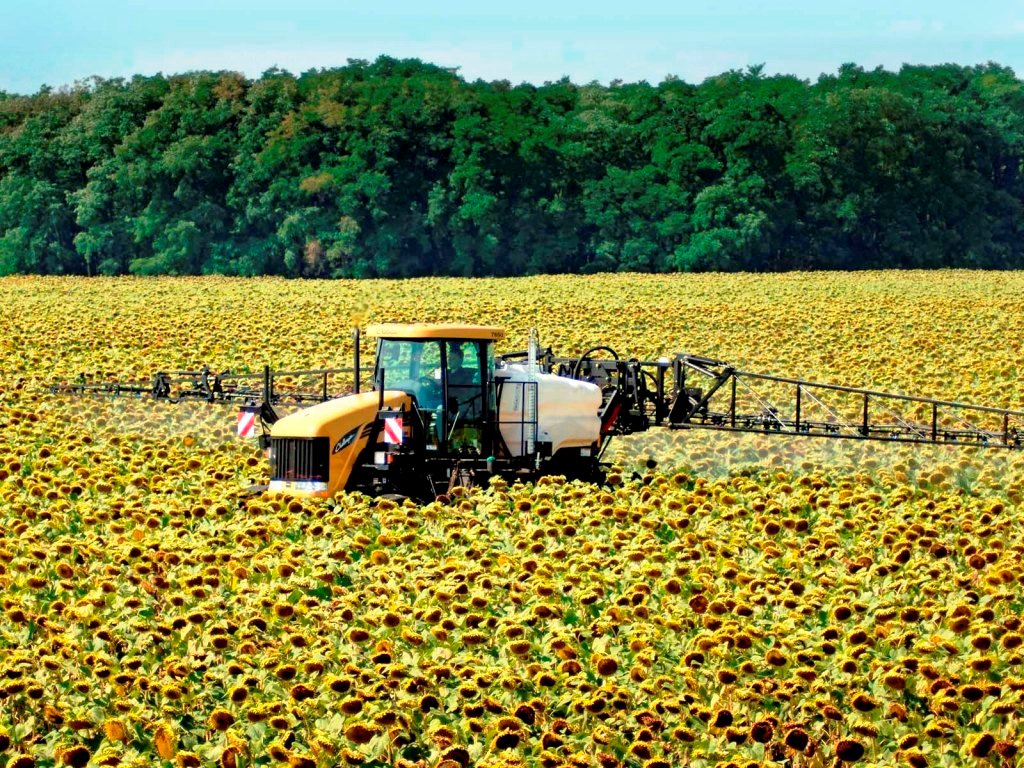
If you are seriously wish to obtaine
sucsess in sunflower growing, then you need a good high-clearance (clearance
of at least 1.8 m) sprayer! It is needed to carry out the necessary
spraying of sunflower in the later stages of plants development (protection
against diseases, pests, foliar fertilizing with fertilizers, growth
stimulants, microelements). Such a sprayer should not damage sunflower
plants. In the photo: Challenger Spra Coupe SC 7000 sprayer (photo©
Challenger-ag.com)
Features of growing
varieties of Strube sunflower in the south drought regions
The
technology of growing sunflower in the south of Ukraine, in the southern
regions, is no different from the technology of conventional cultivation
of sunflower, but there are also specifics that follow from the
differences between a dry hot climate and normal and which must be
consider.
Sunflower
growing in the southern regions, including very arid, has its own
characteristics and is profitable, since sunflower is one of the most
drought-resistant crops:
-
the
right choosing of varieties - you need to select and grow those
varieties Strube that will give maximum effect in the South
-
proper
soil preparation, aimed at maximum moisture conservation in the soil
-
lack of
time gaps between technological operations
-
the
shortest possible dates of not only sowing, but also of all
technological operations
-
give
fertilizers only for the planned yield, taking into account moisture
availability
-
the
right selection of varieties for resistance to broomrape (Orobanche
cumana)
-
sowing
only after cereals in crop rotation
-
sowing
at the earliest optimum time
-
maximum
yields in the South, sunflower gives by drip irrigation (up to 5-6 t/
a)
-
it is
undesirable to use IMI herbicides (Eurolighting, Clearfield and
others), since these herbicides do not decompose completely in arid
conditions and lead to severe restrictions on crop rotation. After
it using may appiar resistant weeds (for example ragweed). But in
the case of the presence of a large number of weeds and with proper
observance of crop rotation and tillage, this is possible
-
many
farmers in the USA and Canada use Strip-Till technology in
combination with CTF, which can increase profits by 20-30% when
growing sunflower in drought conditions
-
take
into account that the range of weeds in the southern regions is
complemented by a very harmful weed for sunflower - ragweed (Ambrosia
artemisiifolia L.), and effective measures to control this weed
should be provided
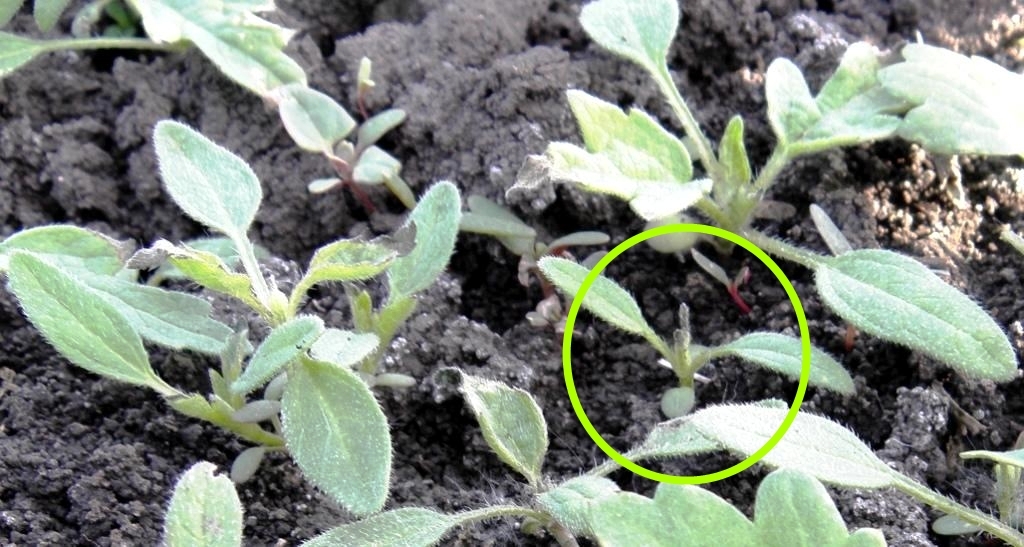
At
the photo: ragweed that not resistant to herbicides (Ambrosia
artemisifolia L.) in the phase of 2 real leaves (circled) in sunflower
field. But difficulty is that in many cases ragweed may be already
resistant to herbicides and need special test before application of
herbicides (photo ©
Dr. Oleksii Orlov).
There are features of treatments against ragweed in sunflower that SU
resistant (tribenuron
methyl).
Against ragweed (Ambrosia artemisifolia L.), you need to use Express®
herbicide, no later than the phase of 2 true leaves in the ragweed. In
this case, the weed dies
Contact
Strube for purchase of high-yield and profitable
sunflower
seeds!
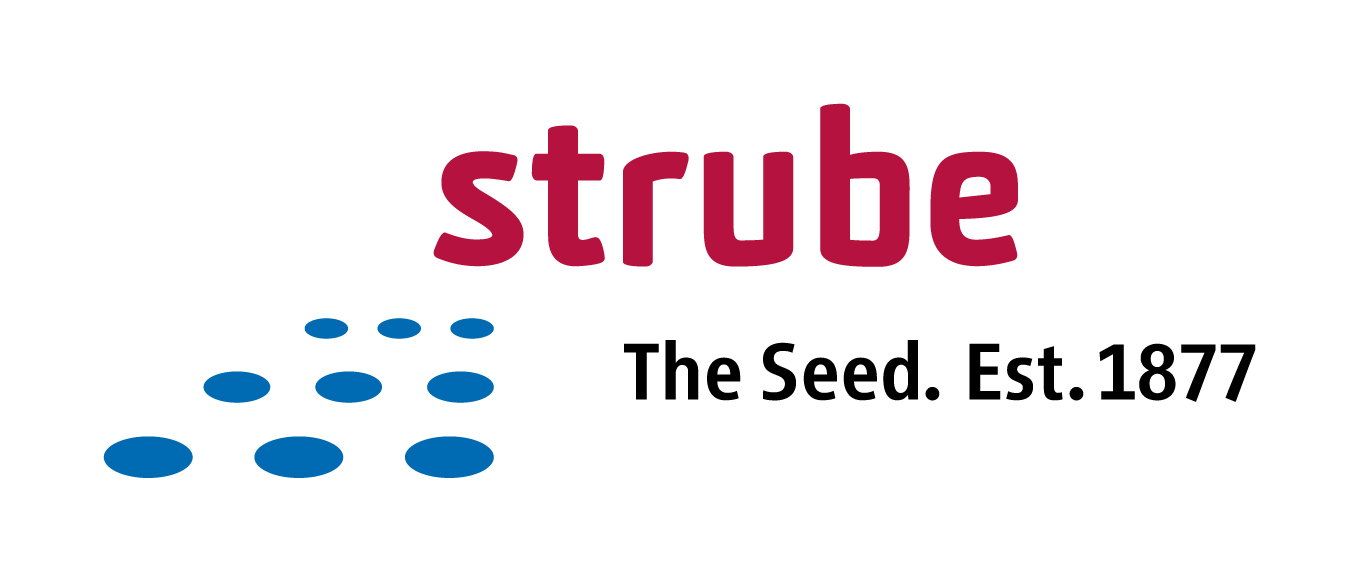
Many thanks for
the help in preparing the article: Strube GmBH,
Dr. Lutz Gerrmann, Dr.
Vasyl Gech
Contacts of Strube
in Ukraine:
TOV Strube Ukraine GmbH
Str. Yuria Shumskogo, 1, Of. 115
2098 Kyiv, Ukraine
Tel. +38 044 536 16 69
info@strube.com.ua
https://www.strube.net/ukraine/
-
-
Please tell Strube that
you are contact from Agricultural Consulting
website!
he Author of this article and Agricultural
Consulting does not sell seeds!
Contact Agricultural Consulting
for advice - we will do a technical audit and give
recommendations about how to get a
biggest wheat yield
in your conditions!
Author′s
of this article
Contacts
Disclaimer
© Agricultural Consulting
Service. Technical audit of agribusiness. Agricultural business projects and
agricultural companies turnkey. Consulting services for agriculture,
aquaculture, natural resources, environment, safe energy in industry and
home construction. Increasing the
profitability of business, obtaining additional profits
|












